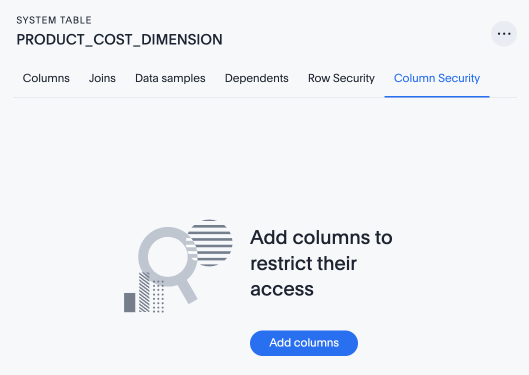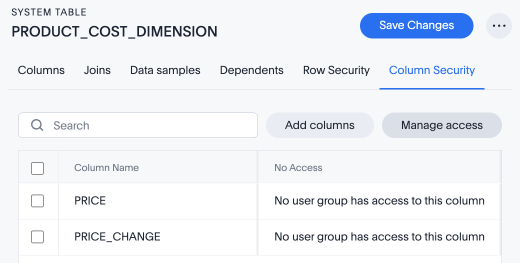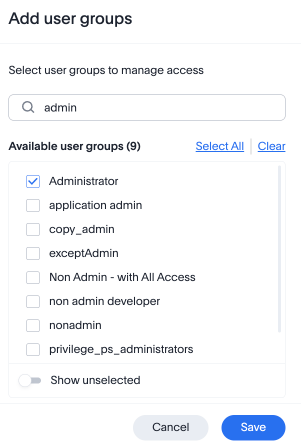Data and object security
ThoughtSpot provides many features for protecting data.
Object security
Object security controls what content users see within ThoughtSpot. Objects are tables, columns in tables, Models, Liveboards, and saved Answers.
Users gain access to objects when an object owner shares access with them. Owners can share with individual users or with entire groups, giving access to everyone within that group. Objects may be shared with edit or view-only options. A user can automatically share objects with anyone else in the groups to which they belong. This has implications on setting up privileges, and on applying row-level security.
Permissive Security mode
The default Permissive Security mode of ThoughtSpot means that when someone shares an object with you, you can see all the data it uses, regardless of explicit permissions to the parent object data. You can see a shared Liveboard without having access to its underlying Model or table.
Advanced Security mode
ThoughtSpot’s Advanced Security mode, or strict column-level security (CLS), is the opposite of the default permissive mode. Unless the user has explicit permissions to the entire stack of parent objects, they cannot see the data in the child object. For example, in a shared Liveboard, you can see data only if you have explicit permissions to the relevant columns of the parent Model. Similarly, you can only see the data in a Model to which you have access if you have explicit permissions to its parent table object.
| We recommend using column security rules rather than Advanced Security or Strict CLS. |
Work with your ThoughtSpot support team to enable the Advanced Security Mode on the relevant clusters.
|
To ensure that ThoughtSpot applies column-level security to table dependents, such as Models, Liveboards, and Answers, you must enable Advanced Security, also called Strict CLS. If you do not enable Advanced Security, users may see data in table dependents that is restricted to them in the tables themselves. After enabling Advanced Security, make sure you share all underlying data (both tables and Models) when you share Answers or Liveboards. If you do not share all underlying data, users can’t see the Answers or Liveboards. ThoughtSpot will return an error. |
Row-level security (RLS)
Row-level security controls what data a user can see in each shared piece of content. Even if a user has access to a Model, they can only see rows from the tables they have permission to see.
RLS applies at the table level, so it automatically extends to all Models, saved answers, and Liveboards based on that table, every time. Also, in queries where there are tables with table filters, all joins are always enforced to avoid accidentally allowing users access to data they shouldn’t see.
RLS requires three things:
-
A table filter with a column (possibly in a joined table) that can be used to determine who can see a row, such as account id or tenant id.
-
A group that can be associated with the row of data by name. For example, if the column is
account_idand has values of1,2,3, users can be assigned to groupsgroup_1,group_2,group_3and then only see their data. -
Users must be assigned to the group. If they are not assigned to a group that has access, they do not see any data.
Administrative users can always see all rows of data because RLS does not apply to them.
RLS supports a hierarchy of groups, which makes it possible to grant access to some users across multiple groups.
Keep in mind that users within a group can share with one another. If you put everyone in your organization into the same group for RLS, they can share with anyone in the company.
Column security rules Early Access
You can now set column security rules at the table level, and they will automatically be inherited to associated Models. These rules do not require you to use the Strict CLS setting. We recommend this approach to column-level security over Strict CLS.
To set column security rules, follow these steps:
-
Click the Column Security tab. Click Add columns.

-
A pop-up appears with a list of columns in the table. Select the checkbox next to the column(s) you want to restrict. You can also select all. Click Save.

-
Columns you selected by default become inaccessible to all user groups. To grant access to certain groups, click Manage access. Select a group or groups from the pop-up to control access.
You cannot specify column security rules at user level. 

-
Toggles appear for each column and group you selected. You can set the toggle to Has access in a cell to grant access to a particular group, or toggle to No access to deny access to the group.

-
If you select the checkbox next to the column name, you have the following options:
-
Grant access to all: Makes the column accessible to all user groups.
-
Remove access for all: Makes the column inaccessible to all user groups.
-
View user groups with access: A list of user groups with access to the column appears.
-
Remove: Removes the column from the column security rules tab and makes it accessible to all users.

-
Column-level security (CLS)
Column-level security lets users see certain columns in a table, but not other columns. This can be accomplished by sharing a limited set of columns in a table with specific users or groups.
Because someone can share with anyone in the same group, they can potentially share restricted columns. For example, if a Human Resources repository has a column with salary information, and it appears in a Model, any Human Resources group member could create an answer with visible salary information and mistakenly share with someone outside of Human Resources. That 'outside' person now has access to the salary information. In such cases, we recommend that you work with your ThoughtSpot support team to enable Advanced Security mode, which allows table dependents (such as Models, Liveboards, and Answers) to inherit a table’s CLS.
System privileges
System privileges refer to what a user can do in ThoughtSpot. For example, can they upload or download data or share with all users. These privileges are defined on a group level and inherit downwards. So, if Group A had child groups Group B and Group C, then any privilege given to Group A is also available to Group B and Group C. What this often means is that separate sets of groups are required to manage privileges.
Related information



